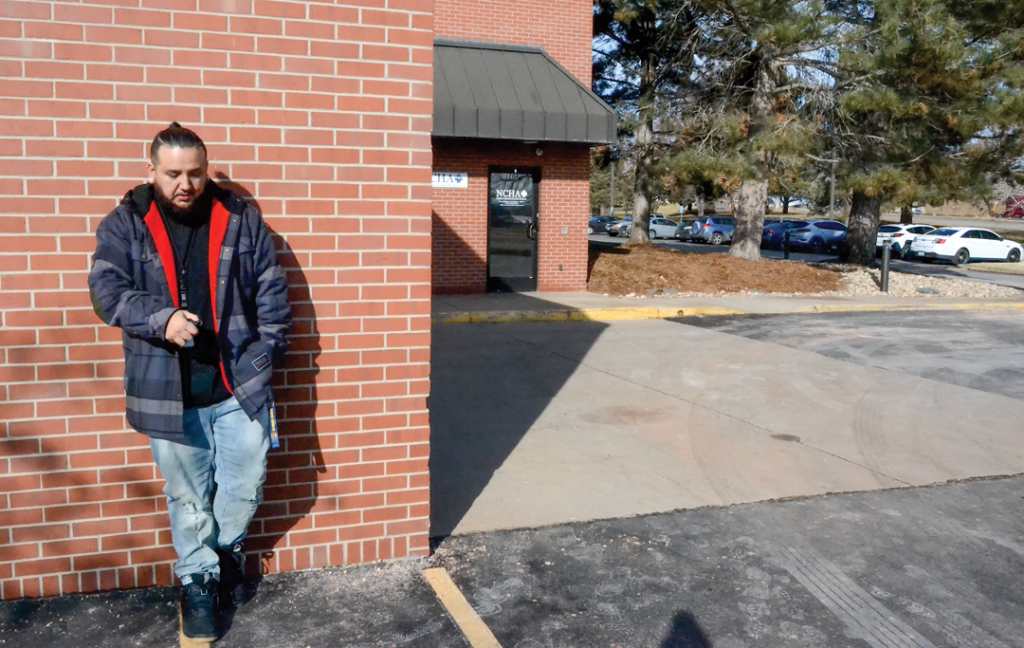Before his back surgery, Chris Mesa watched his family struggle with addiction and thought one thing: That will never be me.
When he lost his first loved one, he was too young to understand what happened. His uncle froze to death under a bridge after a long struggle with alcohol. He watched others, even his parents, through a lens of anger and, at times, hatred, as alcohol flowed through his family like a poisonous river. He wondered why they would choose such a miserable, damaging and selfish lifestyle. He thought he was different from them even as he sold drugs to make money.
Mesa, a Greeley resident, had the last of his four back surgeries in 2015, and it was the most painful. Doctors prescribed him rest and a potent painkiller, an opioid they said would end his misery. It was, in fact, the beginning of it.
“I knew they were addictive,” Mesa says, “but it never crossed my mind that I wouldn’t be able to quit them. I mean, a doctor was giving them to me. They weren’t alcohol or meth, the stuff that I knew I needed to avoid. The pain was bad. I needed the pills. But then your body starts saying you need more of it. And then your mind does.”
Doctors eventually caught on to Mesa’s addiction and cut him off. He went through two weeks of withdrawals and tried to hold down his job while feeling sick.
“I felt like I was dying,” he says.

Chris Mesa, care coordinator for North Colorado Health Alliance. Photo by Dan England.
Some of Mesa’s family eventually went to jail on drug charges. He had to take care of his little sister, and then he found out he had a baby on the way. Those events helped motivate him to stay clean. He did it on his own. He still doesn’t know how. Most people can’t, he says.
He knows that because it’s now his job to help others beat their addictions. His (now ex) wife applied to North Range Behavioral Health for him as a peer specialist. When he interviewed, his only experience was his life experience, but his willingness to share his family’s addiction story as well as his own got him the job.
By then, he understood that addiction isn’t a choice. Mesa, now 35, worked at North Range for several years and recently accepted a job as a care coordinator for North Colorado Health Alliance doing essentially the same thing. He works as a counselor and a bridge for those who want to get help but don’t know how. He visits the jail, hospitals and homeless shelters, seeking out anyone who might want to get sober.
Mesa’s story offers hope amidst an opioid crisis—particularly fentanyl—that kills thousands of people a year and affects many in Colorado. In 2021 and 2022 (the latest data available), more than 1,400 overdose deaths were reported in the state.
That hope is real despite nearly three decades of social workers and health care professionals battling a complex, sometimes embarrassing and at times disgusting and corrupt battle with opioids. Millions of dollars in settlements from Purdue Pharma, the company that precipitated the crisis, and places that handed out the drugs, are now giving treatment centers the ability to hire more staff, open addiction centers and, most importantly, get treatment to those who need it right away.
Mesa is grateful for his own recovery. He sees his three kids every day now. He’s also going back to school at Aims Community College and will soon attend the University of Northern Colorado, where he hopes to eventually get a master’s in psychology. He’s especially excited to work in Greeley, where he grew up and saw so much pain.
“It’s turned my life around,” Mesa says. “I love [the job]. It’s been an awesome experience.”
But the struggle with opioids remains: One of Mesa’s family members overdosed on fentanyl over Thanksgiving. They survived only after another family member came to their rescue.
“It’s everywhere,” Mesa says and sighs. “We are trying to get a grip on this stuff, but it’s hard how much it’s hitting the streets. It hits home. Literally.”
Worse than ever despite progress
Three years ago, Eric Aakko broke his back. He didn’t get the painkillers Mesa got years ago.
“They didn’t give me anything,” Aakko says.
Aakko isn’t whining about that. He says it to show how the medical field has changed their process for prescribing opioids. In 2017, UCHealth’s ER departments were among the first to focus on reducing the administration of opioids and turning to other painkillers, says Kelly Tracer, spokeswoman for UCHealth. They also started an education campaign to inform people about the risks of opioids and encourage them to talk to their doctor about them.
“The problem isn’t the prescriptions anymore,” says Aakko, director of the communications division for the Weld County Department of Public Health and Environment.
Lesley Brooks, who serves as assistant medical director of the North Colorado Health Alliance and chief of addiction medicine for SummitStone Health Partners, says the medical community talked about how to manage chronic pain without opioids way back in 2011 during her residency and later during her nine years with Sunrise Community Health.
“Primary care physicians were not used to treating addiction at the time,” Brooks says. “They had to be trained on how to recognize the misuse of that med. People were ringing the bell in the 2000s.”
And yet, the crisis is arguably worse than ever. Although nearly a million people have died nationwide from an opioid overdose since 1999, according to the Centers for Disease Control and Prevention (CDC), the number of people who died in 2021 was 10 times the number in 1999.
The CDC refers to the current crisis as the third wave of opioid overdose deaths. The first started in the 1990s with prescription opioids, which is what you see in shows such as “Painkiller” on Netflix. The second wave started in 2010 with a dramatic rise in heroin overdoses. The third and current wave is the rise of synthetic opioids, including the drug commonly known as fentanyl. Synthetic opioids, or “street opioids,” killed 20 percent more people in 2021 than in 2020.
North Range’s drug treatment experts don’t have numbers on those addicted to opioids as opposed to meth or alcohol, the three many identify as the main problems in the addiction world (heroin is considered an opioid). But there is little doubt that opioids have emerged as the crisis of the moment, or at least enough so that they’re getting significant attention.
Mesa believes that attention is warranted. He’s most worried about fentanyl, and many, if not most, of the people he sees are hooked on it. Fentanyl is potent and prevalent. Aakko says he’s seen it advertised on social media in rainbow-colored pills, and Mesa says synthetics look exactly like the “blueberries” he took for his back pain.
The fear of quitting
Beating any addiction is incredibly difficult, and despite all the treatments available now, no one really knows why some can do it and many others can’t. But fentanyl is harder than most, if not all, to kick because the withdrawal symptoms are so bad that they terrify those addicted to it.
One of Mesa’s most heartbreaking clients was a 16-year-old girl who was sobbing because she wanted to quit but was so afraid of the intense pain of the withdrawals. Those symptoms are treatable through medication, but they don’t stop all of the pain, which Mesa describes as a full-body cramp powerful enough to make your eyes roll back. He believes the symptoms are 10 times more powerful than what he felt while kicking his opioid addiction.
Sheri Hein saw a lot of meth for a good portion of her career as director of Wings, a program at North Range that helps pregnant women and women with addictions who have small children. The withdrawals, cravings and potential for addiction is much greater with fentanyl, she says, and so is the toll it takes on the body.
Meds do work, so much so that medication-assisted treatment (MAT) programs like the one at North Range have proven successful. Just like all other treatments, the meds that target opioid addiction, such as methadone, aren’t a cure by themselves, but they do reduce the cravings enough that addicts can focus on other parts of their recovery.
“It helps the client stay engaged longer with treatment,” Hein says.
While the fear of withdrawal prevents many addicts from trying to quit, the stigma surrounding addiction may be the biggest reason why they don’t enter treatment, says Jennifer Miller, program director of integrated care for North Range. Hein says the stigma is by far the biggest problem in her program because the women don’t want to be seen as bad mothers.
“There’s a fear of taking a chance and asking for help,” Miller says. “There’s a fear of losing support from your friends and loved ones. There’s a fear of being labeled. There’s a fear of failing.”
MJ Jorgensen (they/them), director of addiction response for North Colorado Health Alliance, is considered a leader in addiction treatment in Northern Colorado. They say they fight the stigma all day, every day, though the stigmas are misguided. There are many reasons why people use, and many of them are heartbreaking.
“I had a client experiencing homelessness who began using stimulants because she was afraid to fall asleep at night,” Jorgensen says. “If she was housed and safe, she may not have ever used.”
Hein says most of the women in her program have experienced some form of long-term abuse or horrific trauma.
“Fentanyl is a good way to numb that,” she says.
Jorgensen calls opioid use a “wicked problem,” a term those in social and public health use to describe yet another tangled, complex issue of society.
“This is a big, knotted nightmare,” Jorgensen says. “We need to change people’s hearts and minds about what addiction is and what it is not.”
Poisonings
One of the main reasons fentanyl has killed so many people recently is that some don’t even realize they’re taking it. Dealers lace it with other drugs to make them more addictive and, in theory, increase sales. And, as others previously mentioned, fentanyl can look like anything, from candy to prescription drugs.
This is how Mesa’s loved one overdosed on Thanksgiving: They took a pill someone gave them for back pain. It was fentanyl. They stopped breathing.
Another family member revived them through CPR and by using Narcan, an injection or nasal spray that can quickly restore breathing to someone who has overdosed on opioids.
“Thank God the Narcan was there,” Mesa says. “Some are choosing to engage with fentanyl but others aren’t. They don’t know what they’re getting.”
Overdoses are so rampant that health officials have battled fentanyl with a harm reduction strategy. This can be controversial because some believe having Narcan in public places encourages the use of opioids, the same type of argument others use about placing condoms in bathrooms.
The number of deaths has also encouraged those outside addiction and medical communities to get involved, such as Aims Community College. Their student life department has dedicated a significant amount of resources to educating people about the dangers of fentanyl and making sure Narcan is available in many visible spots around campus. Janet Chase, director of student life at Aims, is unapologetic about this. Some of her own staff have lost loved ones to fentanyl.
“We don’t think scare tactics or preaching abstinence works,” Chase says. “We want to get Narcan into everyone’s hands. Fentanyl is in everything now.”
Chase also says most of the effort is student-driven, mainly because so many students know people who use or have lost someone close to them due to fentanyl poisoning.
One day at a time
Mesa now knows he has ankylosing spondylitis, a chronic form of arthritis that causes inflammation in the spine, pelvis and hips. He gets an injection for it once a week, and while he still has pain, it’s nowhere near what he once dealt with. Had he not experienced the severe pain it causes, he likely would not have been hooked on drugs, and he can say the same for a decent chunk of his patients. Mesa admits he was at risk anyway because of his family’s struggle with addiction and the likelihood that he probably has what many scientists believe is an addictive gene.
He’s been sober for five years, and he says he was lucky. His three kids got him through it. But he worries about his oldest, a teenager.
“I’d like to know what’s going on in her head,” Mesa says and smiles. “But they don’t tell you.”
He loves his work, but it is also a draining and heartbreaking job to meet with addicts all day, hear their terrible stories and believe he’s reaching them, only to have them fail. Breakthroughs can happen, and two days later, he will hear that the person died of an overdose.
“It will hurt you,” Mesa says. “But you get these clients who [recover] and they are grateful for you. Knowing that you helped someone and seeing them succeed is the reward.”
He’s had to learn how to approach addicts with open arms and let go of any judgment. His own history helps him do that, but he admits he would not have been able to do that growing up in an alcoholic family.
“I look at the world differently now,” Mesa says.
Still, he needs to decompress at times. His kids are part of that, he says, but he also bought a keyboard and has turned to making music again. It’s the best self-care, he says, as he spends much of his weeks playing songs of hope for anyone who needs it.







